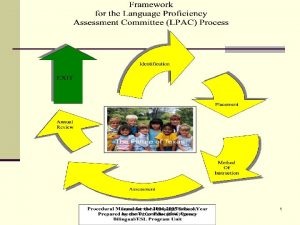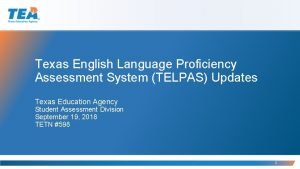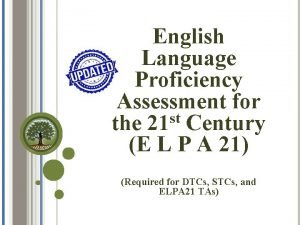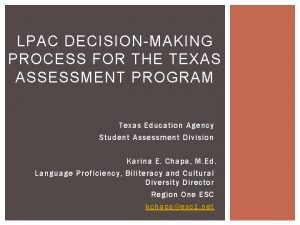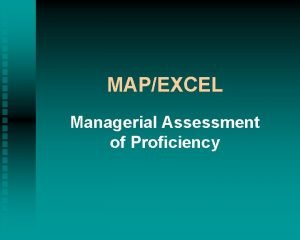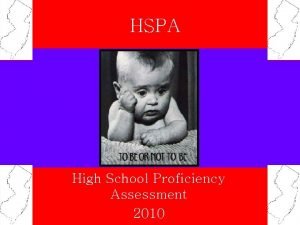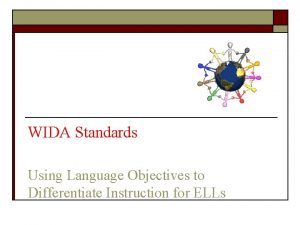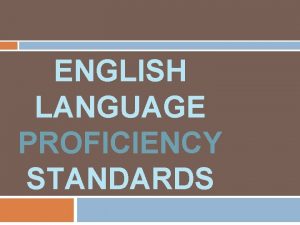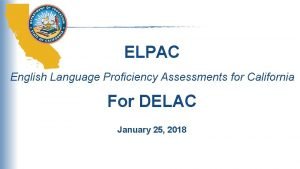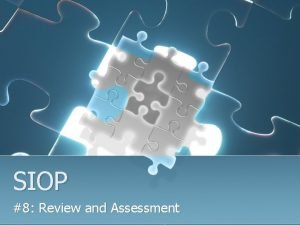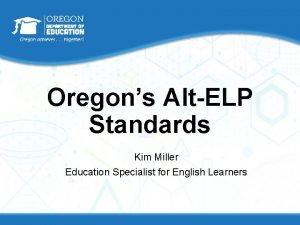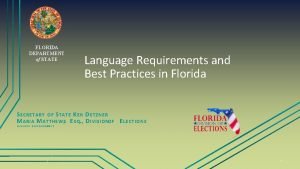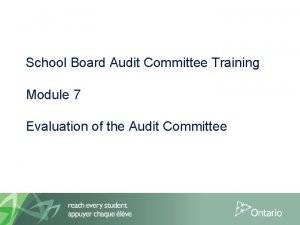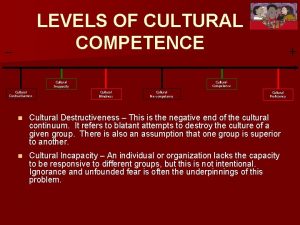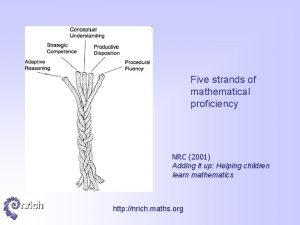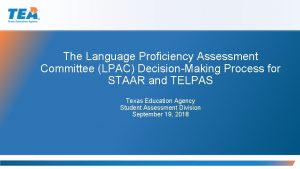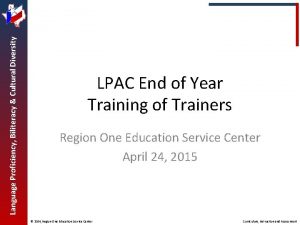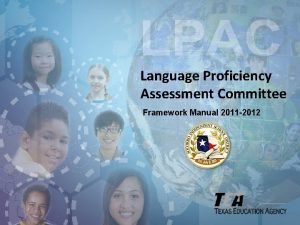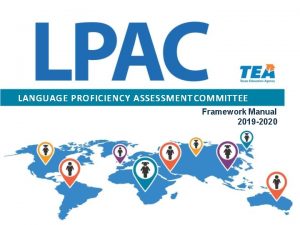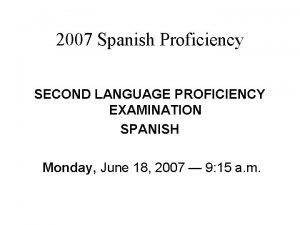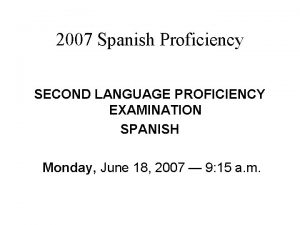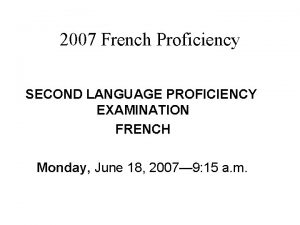Framework for the Language Proficiency Assessment Committee LPAC





































































































- Slides: 101

Framework for the Language Proficiency Assessment Committee (LPAC) Process 1

Bilingual/ESL Education Program Commonly Used Acronyms: n LEP Limited English Proficient n ELL English Language Learner n HLS Home Language Survey n PEIMS Public Education Information Management System Framework for the Language Proficiency Assessment Committee (LPAC) Process 4

Bilingual/ESL Program Assessment Acronyms n TAKS Texas Assessment of Knowledge and Skills n TELPAS Texas English Language Proficiency Assessment System (2 components): OP - Observation Protocol (Grades K-12) RPTE - Reading Proficiency Tests in English (Grades 3 -12) n OLPT Oral Language Proficiency Test Framework for the Language Proficiency Assessment Committee (LPAC) Process 5

Introduction 19 Texas Administrative Code (TAC) Chapter 89. Adaptations for Special Populations. Subchapter BB. The Commissioner’s Rules Concerning the State Plan for Educating Limited English Proficient Students state that all school districts that are required to provide bilingual education and/or English as a Second Language (ESL) programs establish and operate a Language Proficiency Assessment Committee (LPAC). Framework for the Language Proficiency Assessment Committee (LPAC) Process 6

Purposes of the LPAC Process Manual The Manual integrates state and Title III Of Public Law 107 -110 (No Child Left Behind) requirements regarding the: n Identification and placement n Parent notification n Annual review and n Assessment of English language learners as they attain language and academic proficiency. Framework for the Language Proficiency Assessment Committee (LPAC) Process 8

Purposes of the LPAC Process Manual The Manual delineates the steps that must be followed in the: q identification q processing q placement q monitoring of LEP students in their intensive language instruction program as well as the determination for the exit and follow up of students as they transition into an all-English program. Framework for the Language Proficiency Assessment Committee (LPAC) Process 10

The Framework for the LPAC Process Manual can be accessed through the TEA website at: www. tea. state. tx. us/curriculum bilingual. html. Framework for the Language Proficiency Assessment Committee (LPAC) Process 12

Bilingual or ESL? How do we know if we should have a Bilingual/ESL program or an ESL program? Framework for the Language Proficiency Assessment Committee (LPAC) Process 13

Bilingual or ESL? n The law requires that each school district or charter school which has an enrollment of 20 or more LEP students of the same language classification in the same grade level district-wide shall offer a bilingual education program for LEP students in Grades Pre-K through 5 n Grade 6 shall be included when clustered with elementary grades 19 TAC § 89. 1205 (a) Framework for the Language Proficiency Assessment Committee (LPAC) Process 14

Bilingual Education n Content area instruction is provided in both the student’s primary language and English n Development of literacy in the primary language which transfers to English n Oral language testing requirements in both the primary language and English n ESL is a component of the bilingual program Framework for the Language Proficiency Assessment Committee (LPAC) Process 15

English as a Second Language (ESL) English as a Second Language is implemented… n through the integrated use of second language methods throughout the curriculum n through instruction that includes TEKS based academic content as well as language development n by differentiating instruction of content according to language proficiency levels n through academic instruction that is on-level, not watered down Framework for the Language Proficiency Assessment Committee (LPAC) Process 17

Bilingual / ESL education must address the following program components: • Affective – Cultural background and positive self esteem • Linguistic – Literacy skills (listening, speaking, reading, writing, comprehension) • Cognitive – Academic skills Framework for the Language Proficiency Assessment Committee (LPAC) Process 18

LPAC Membership How do we know where to begin? Framework for the Language Proficiency Assessment Committee (LPAC) Process 19

LPAC Membership Language Proficiency Assessment Committee Framework for the Language Proficiency Assessment Committee (LPAC) Process 20

LPAC Membership In a nutshell… LPAC committees are responsible for identifying students, recommending the best instructional setting, and monitoring academic and linguistic progress for Limited English Proficient (LEP) students. All of the information available should be reviewed carefully and decisions should be made ethically and in good conscience concerning each child on an individual basis. Framework for the Language Proficiency Assessment Committee (LPAC) Process 21

LPAC Membership How is an LPAC different than an ARD* committee? *ARD is the Admission, Review, and Dismissal committee for Special Education. Framework for the Language Proficiency Assessment Committee (LPAC) Process 22

LPAC Membership n The LPAC can discuss multiple children in the same meeting n The LPAC has a parent representative for all LEP kids, not just the individual child’s parent n The Bilingual/ESL Program does not need parent permission for testing language proficiency n The ARD committee places student in the Special Education Program; LPAC member must be present at the ARD of any LEP student (an ARD committee member does not need to be present at an LPAC, but it is encouraged) Framework for the Language Proficiency Assessment Committee (LPAC) Process 23

LPAC Membership What are the roles and responsibilities of an LPAC? Framework for the Language Proficiency Assessment Committee (LPAC) Process 24

LPAC Membership n Determines LEP status after reviewing scores of entry criteria n Recommends the appropriate educational program for each LEP student n Notifies the parent about classification and obtains permission in writing for program entry n Determines the best state testing option for each LEP student (immediately prior to state assessment) Framework for the Language Proficiency Assessment Committee (LPAC) Process 25

LPAC Membership n Facilitates and reviews student participation and progress in the district’s Bilingual or ESL program n Facilitates the participation of eligible LEP students in other special programs provided by the district with either state or federal funds. n Determines exit status (reclassification as Non-LEP) upon reaching state exit criteria. n Monitors progress of exited students for 2 years Framework for the Language Proficiency Assessment Committee (LPAC) Process 26

LPAC Membership LPAC COMMITTEE MEETINGS When does the LPAC convene? Framework for the Language Proficiency Assessment Committee (LPAC) Process 27

LPAC Membership n Upon initial enrollment- within the student’s first 4 weeks (20 school days) n Immediately prior to assessments n At the end of the year for annual review and for the following year’s placement decision n As needed to discuss student needs Framework for the Language Proficiency Assessment Committee (LPAC) Process 28

LPAC Membership Who serves on an LPAC committee? Framework for the Language Proficiency Assessment Committee (LPAC) Process 29

LPAC Membership Composition of the LPAC: For Bilingual Programs (at least 4 members): n *A campus administrator n *A professional bilingual educator n *A professional transitional language educator n *A parent of a current limited English proficient student (this parent may not be an employee of the school district) *All must be present Framework for the Language Proficiency Assessment Committee (LPAC) Process 30

LPAC Membership For ESL Programs (at least 2 members): n *One or more professional personnel (it is recommended that this include a campus administrator and a certified ESL teacher) n *A parent of a limited-English proficient student participating in the program designated by the district (this parent may not be an employee of the school district) *must be present Framework for the Language Proficiency Assessment Committee (LPAC) Process 31

LPAC Membership LPAC Training: n All LPAC members must be trained n If one of the members does not understand English (parent), the training should be developed in the member’s primary language n At the LPAC meeting, an interpreter should be available in case the parent is LEP n The parent volunteers his/her participation in the LPAC. Framework for the Language Proficiency Assessment Committee (LPAC) Process 32

LPAC Membership n Conferencing with parents at some point about children’s success is encouraged, however, it is not necessary to invite the parent of each of the students being discussed to the LPAC meeting. n Parents are encouraged to become involved in the education of their son/daughter. Information related to meetings or conferences such as the Title III Management Institute serves to increase the parents’ involvement in the education of their children. Framework for the Language Proficiency Assessment Committee (LPAC) Process 33

LPAC Membership n The trained LPAC parent serves as the representative parent for all LEP students. Anyone that is at these meetings must be trained in order to follow the process accordingly. (A recommended training agenda and LPAC quiz are included in the Manual. ) n Each trained member should also sign an oath of confidentiality (sample included in the Manual) because test and other information that is shared analyzed for all students must be considered with respect to each student and his/her family’s right to confidentiality. Framework for the Language Proficiency Assessment Committee (LPAC) Process 34

The LPAC Process What happens at a meeting? Framework for the Language Proficiency Assessment Committee (LPAC) Process

LPAC Membership LPAC meetings*: n All required members are given prior notification of n n n n meeting All required members meet and a chair is selected for the meeting Members review and discuss student data and information Members arrive at appropriate decisions Members sign and date all documentation/LPAC forms Decisions are included in LPAC minutes Committee meeting is adjourned Documentation is filed in appropriate student folder * Sample forms for LPAC meetings are included in the Manual. Framework for the Language Proficiency Assessment Committee (LPAC) Process 36

A Closer Look at the LPAC Responsibilities What decisions do we make? Framework for the Language Proficiency Assessment Committee (LPAC) Process

LPAC Responsibilities n Identification n Assessment and documentation LEP Decision Chart in Manual review n Placement n Instructional methodologies and/or interventions n Coordination n Parental Notification/Consent n Annual Review (linguistic & academic progress) Framework for the Language Proficiency Assessment Committee (LPAC) Process 38

LPAC Responsibilities Identification n Home Language Survey (HLS) n If the HLS indicates a language other than English, testing must be initiated to determine English proficiency* *Parent permission for language proficiency testing is not required. Framework for the Language Proficiency Assessment Committee (LPAC) Process 39

LPAC Responsibilities n Grades PK-1 = a TEA approved oral language proficiency test (OLPT) in English (and primary language for bilingual programs) n Grades 2 -12 = a TEA approved oral language proficiency test (OLPT) in English (and primary language for bilingual programs) and the reading and language arts sections of an English norm-referenced standardized achievement test approved by the state (unless the English ability is so low that it would invalidate the test) Framework for the Language Proficiency Assessment Committee (LPAC) Process 40

LPAC Responsibilities n The person administering the oral language proficiency test must have documentation of training in the administration and scoring of the test AND must be proficient in the language of the test. Framework for the Language Proficiency Assessment Committee (LPAC) Process 41

LPAC Responsibilities Timeline n The campus/charter school has 4 weeks (20 school days) to complete the testing and meet to determine the LEP status of each student. Non-LEP? Framework for the Language Proficiency Assessment Committee (LPAC) Process 42

LPAC Responsibilities Results must be evaluated to determine if student is LEP… HOW? Framework for the Language Proficiency Assessment Committee (LPAC) Process 43

LPAC Responsibilities PK-1 students whose OLPT score indicates limited English proficiency are identified as LEP. Framework for the Language Proficiency Assessment Committee (LPAC) Process 44

LPAC Responsibilities n Grades 2 -12 students are identified LEP if their OLPT score indicates limited English proficiency and/or n If they score below the 40 th percentile on the reading and/or language arts sub-test of a state-approved norm-referenced standardized achievement test even if their OLPT score indicates English proficiency Framework for the Language Proficiency Assessment Committee (LPAC) Process 45

LPAC Responsibilities Results must be evaluated to determine if student is LEP… By whom? Framework for the Language Proficiency Assessment Committee (LPAC) Process 46

LPAC Responsibilities By the LPAC… that’s who! The committee must meet and review the test results to determine LEP status…not the tester! Framework for the Language Proficiency Assessment Committee (LPAC) Process 47

LPAC Responsibilities Placement/Permission n After the LPAC recommends placement for the LEP student, written parental permission must be obtained! n Remember the parent notification needs to be in both English and the native language of the parent! Framework for the Language Proficiency Assessment Committee (LPAC) Process Parent Notification forms in manual 48

LPAC Responsibilities Parental Rights n Parent notification includes information regarding the English proficiency level of the student and a description of the program as well as the benefits of the program. n These benefits are to be described on each parent notification form and supplemented through brochures or other publications in the community. Bilingual/ESL program brochures are available in English and Spanish through the Texas Education Agency at: www. tea. state. tx. us/curriculum/bilingual. html. Framework for the Language Proficiency Assessment Committee (LPAC) Process 49

LPAC Responsibilities So… when students first enroll, where do we place them while we are carrying out this process and waiting for permission? Framework for the Language Proficiency Assessment Committee (LPAC) Process 50

LPAC Responsibilities Placement Pending parent approval of a LEP student’s entry into the Bilingual/ESL program, the district/charter school will place the student in the recommended program, but may count only LEP students with parental approval to receive the Bilingual/ESL education allotment. Framework for the Language Proficiency Assessment Committee (LPAC) Process 51

LPAC Responsibilities n The LPAC may also recommend other programs or services offered through the district, such as tutoring, supplemental services, etc. . . n The LPAC is also responsible for facilitating student participation in other special programs – Advanced Academics (G/T) or Special Education, CATE (Career and Technology) Framework for the Language Proficiency Assessment Committee (LPAC) Process 52

LPAC Responsibilities Parental Approval/Denial PEIMS Date The date that the parent notification form is signed is the date the student’s official PEIMS status becomes LEP (when they can be counted as LEP), regardless of permission or denial. Framework for the Language Proficiency Assessment Committee (LPAC) Process 53

LPAC Responsibilities Parent Denials n If a parent denies the placement decision, then the student is identified in PEIMS as LEP with a parent denial until the student meets exit criteria. n It is recommended that the progress of the LEP student with a parent denial on file be closely monitored. Framework for the Language Proficiency Assessment Committee (LPAC) Process 54

LPAC Responsibilities To clarify n “LEP” is a status of identification n PEIMS is an identification system used to report to the state n “ESL” or “Bilingual” is a program used to provide services required to serve eligible students Framework for the Language Proficiency Assessment Committee (LPAC) Process 55

LPAC Responsibilities What do we have to do for students with parent denials? Framework for the Language Proficiency Assessment Committee (LPAC) Process 56

LPAC Responsibilities Parent Denials n Monitor and facilitate the educational process – we want all students to be successful n Rate student’s listening, speaking, reading, and writing proficiency with the Observation Protocols (beginning at Grade K through Grade 12) n Administer the RPTE beginning at Grade 3, until the child scores “advanced” Framework for the Language Proficiency Assessment Committee (LPAC) Process 57

LPAC Responsibilities Parent Denials n The LPAC must review student’s RPTE/TAKS scores at the end of each year n Once a student meets exit criteria (TAC Chapter n § 89. 1225) he/she is reclassified as non-LEP in PEIMS n Students with parent denials are also monitored for two additional years (Title III, Part A, Subpart 2. Sec. 3121(a)(4) Framework for the Language Proficiency Assessment Committee (LPAC) Process 58

LPAC Responsibilities What do we do when a student transfers in from another school? Framework for the Language Proficiency Assessment Committee (LPAC) Process 59

LPAC Responsibilities If the student transfers from a school in Texas… n Review the withdrawal form, if available, to see if he/she was being served in a program or identified LEP in PEIMS n Try to get as much original documentation as possible, especially the HLS (document your attempts) n LPAC identifies and places student within the first 4 weeks of enrollment. Be sure that all of the necessary signed documents are in the student’s LPAC folder. Framework for the Language Proficiency Assessment Committee (LPAC) Process 60

LPAC Responsibilities If the student transfers from a school outside of Texas… n Review any documentation brought in by the student n Proceed with Texas law for identification as outlined for Texas students new to the district Framework for the Language Proficiency Assessment Committee (LPAC) Process 61

LPAC Responsibilities Annual Review Forms in Manual Framework for the Language Proficiency Assessment Committee (LPAC) Process 62

LPAC Responsibilities Annual Review At the end of the year, the committee reviews every LEP child being served n with parental denials n exited during the previous 2 years that are being monitored n who has met exit criteria and continues to monitor students for 2 additional years n Framework for the Language Proficiency Assessment Committee (LPAC) Process 63

LPAC Responsibilities What is reviewed? Any data that is available that can be used to make good, sound decisions on the following year’s placement, for example: n Benchmarks n Classroom Tests n State Criterion Test Data (TAKS) n Norm-referenced Standardized Achievement Test Data (ITBS, SAT, MAT-8, etc. ) n Oral Language Proficiency Test Data n Reading Proficiency Test Data (RPTE, TPRI, Tejas Lee etc. ) n Observation Protocols Data n Grades n Anything that will give a well-rounded picture of the student’s growth and progress Framework for the Language Proficiency Assessment Committee (LPAC) Process 64

LPAC Responsibilities When do we make decisions about state assessments? Framework for the Language Proficiency Assessment Committee (LPAC) Process 65

LPAC Responsibilities Assessment decisions are made sometime in early spring before testing What are some options for assessment? Framework for the Language Proficiency Assessment Committee (LPAC) Process 66

LPAC Responsibilities Exemptions and Postponement (3 -10) (exit) n For complete exemption policies – see the policy manual entitled LPAC Decision-Making Process for the Texas Assessment Program (grades 3 -12) This manual is available at the TEA website: http: //www. tea. state. tx. us/student. assessment/resources/guides/lpac/index. html Framework for the Language Proficiency Assessment Committee (LPAC) Process 67

LPAC Responsibilities When do students exit the bilingual or ESL program? Framework for the Language Proficiency Assessment Committee (LPAC) Process 68

LPAC Responsibilities Exiting from the Program 19 TAC§ 89. 1225(h) The student’s oral and written language proficiency development must be taken into account by the LPAC when making determinations regarding the student’s LEP status. Framework for the Language Proficiency Assessment Committee (LPAC) Process 69

LPAC Responsibilities Exiting from the Program (continued) in conjunction with one of the following two criteria: 1) A student who has been determined as Limited English Proficient (LEP), must achieve in the 40 th percentile or higher on the language arts and reading portions (only) of a norm-referenced standardized achievement test. Framework for the Language Proficiency Assessment Committee (LPAC) Process 70

LPAC Responsibilities Exiting from the Program (continued) 2) The student meets state performance standards on the reading and writing portions (when available) on the English Language criterion referenced test (TAKS). TEC § 39. 023 Framework for the Language Proficiency Assessment Committee (LPAC) Process 71

LPAC Responsibilities Exiting from the Program (continued) Bilingual Program Only In addition to the stated exit criteria, the student’s proficiency in his/her native oral and written language must be assessed. 19 TAC § 89. 1225(h)(1) Framework for the Language Proficiency Assessment Committee (LPAC) Process 72

LPAC Responsibilities n Once the LPAC reclassifies a student as non-LEP, parents must be notified that the student has met state criteria for exit and will be monitored for 2 years. n Parent notification of the student’s exit must be present in the student’s record folder Framework for the Language Proficiency Assessment Committee (LPAC) Process 73

LPAC Responsibilities Requirements for lower grades Students in Pre-Kindergarten, and 1 st grade may not be exited from a bilingual education or English as a second language program. An annual review is still conducted by the LPAC, but the LEP student cannot be reclassified as English proficient (non-LEP) at these grade levels. Framework for the Language Proficiency Assessment Committee (LPAC) Process 74

LPAC Responsibilities n The LPAC must ensure that the exit decisions are appropriate so that reclassification as LEP and re-entry to a Bilingual/ESL program can be avoided. n All members should be confident in the decision to exit each student using the state criteria. “An ounce of prevention is worth a pound of cure” Ben Franklin Framework for the Language Proficiency Assessment Committee (LPAC) Process 75

LPAC Responsibilities What happens after LEP students exit the Bilingual or ESL program? Framework for the Language Proficiency Assessment Committee (LPAC) Process 76

LPAC Responsibilities Monitoring Exited Students n The LPAC committee is also responsible for monitoring exited students for the two years that follow the year that they exit the Bilingual or ESL program. n Monitoring consists of incremental, documented review of grades, academic progress, TAKS scores, etc. . . Framework for the Language Proficiency Assessment Committee (LPAC) Process 77

LPAC Responsibilities What if exited students are not successful in the mainstream classroom? Framework for the Language Proficiency Assessment Committee (LPAC) Process 78

LPAC Responsibilities Reclassifying Exited Students n Newly exited students naturally experience adjustments to the mainstream classroom environment. n Districts should be aware of this and utilize all available resources to ensure former LEP students continue to achieve academic success. n Communication between the Bilingual /ESL teacher and the regular mainstream teacher during the year is important in case an LPAC meeting is needed to discuss the student’s reclassification or to discuss any other needed interventions. n Districts receiving Title III funding also need to follow any parental notification requirements as specified in the federal law when placing and exiting LEP students. Framework for the Language Proficiency Assessment Committee (LPAC) Process 79

Coordination Effective communication and coordination will ensure that LEP students receive on -going and consistent support from all of the programs in which they are participating. Framework for the Language Proficiency Assessment Committee (LPAC) Process 80

Coordination n The LPAC does not work in isolation. n The LPAC seeks, inquires, shares, assesses and recommends viable strategies to other entities working with the student. n LPAC committee decisions impact overall instruction of LEP students. Framework for the Language Proficiency Assessment Committee (LPAC) Process 81

Coordination n Written documentation becomes invaluable for collaborating and coordinating programs for LEP students. n Parent input and notification is necessary throughout the LPAC process. Framework for the Language Proficiency Assessment Committee (LPAC) Process 82

Coordination n Integration of Chapter 89 and Title III of NCLB Program Requirements n Special Program Coordination n LEP/Special Education Program n Gifted and Talented Program n Summer Program for K-1 LEP Students n PEIMS Framework for the Language Proficiency Assessment Committee (LPAC) Process 83

Coordination Comparison of State Bilingual Education and NCLB Title III Requirements n A side-by-side chart of activities for LEP students as required by state law and Title III of No Child Left Behind (NCLB) is found in the Manual. Framework for the Language Proficiency Assessment Committee (LPAC) Process 84

Coordination The Special Program/Content Area Collaboration form will facilitate coordination among all teachers who serve LEP students. Components addressed: n Linguistic n Cognitive n Affective/Behavior Framework for the Language Proficiency Assessment Committee (LPAC) Process 85

Coordination Prior to the identification of a student as LEP, the LPAC can determine that a… student has a disability that is not related to limited English proficiency and that the student is not LEP, therefore the student should be served in special education and NOT in the Bilingual/ESL education program. Framework for the Language Proficiency Assessment Committee (LPAC) Process 86

Coordination with the Special Education Program Included in the Manual are: n Variables to address when making special education placement decisions n Articles regarding special education and English language learners Framework for the Language Proficiency Assessment Committee (LPAC) Process 87

Coordination The LPAC can determine that a… student was identified as LEP and does not appear to have any disability therefore, the student should be served by the Bilingual/ESL education program and NOT referred to special education unless there is data that indicates a disability. Framework for the Language Proficiency Assessment Committee (LPAC) Process 88

Coordination The LPAC can determine that a… student has a disability identified by the special education program and is limited English proficient (LEP). The student could be served by both programs, special education and Bilingual/ESL education. Framework for the Language Proficiency Assessment Committee (LPAC) Process 89

Coordination with the Special Education Program n For LEP students referred to special education, an LPAC professional member must serve on the Admission, Review and Dismissal (ARD) committee whenever the ARD meets. Framework for the Language Proficiency Assessment Committee (LPAC) Process 90

Coordination What about G/T services? Framework for the Language Proficiency Assessment Committee (LPAC) Process 91

Coordination n Districts should have policies in place for identifying gifted LEP children. n Teachers need to be trained to observe cues that indicate giftedness and follow up with referrals. n Schools should have access to non-verbal intelligence tests and native language tests available for LEP children. n Refer to Chapter 89, Chapter 29, Chapter 42 and TAC Title 19, Part II. Framework for the Language Proficiency Assessment Committee (LPAC) Process 92

Coordination Summer School Programs n 19 TAC § 89. 1250 Required Summer School Programs n TEA Correspondence/Summer School Program for Limited English Proficient students for Kindergarten and first grade n Samples of Summer Program Parent Surveys included in Manual Framework for the Language Proficiency Assessment Committee (LPAC) Process 93

Coordination PEIMS Data PEIMS required submissions for LEP students are included in the Manual. Also included is a listing of PEIMS: n LEP related data elements n Data element definitions n Home language codes n Parental permission codes Framework for the Language Proficiency Assessment Committee (LPAC) Process 94

Coordination PEIMS Division information can be accessed at: www. tea. state. tx. us/peims/ Framework for the Language Proficiency Assessment Committee (LPAC) Process 95

APPENDIX A set of forms are included for ease in duplication and training n Student folder checklist n LEP student documentation checklist n Answers to LPAC quiz n List of approved tests for assessment of LEP students n ESC and district personnel directories Framework for the Language Proficiency Assessment Committee (LPAC) Process 96

Instructional Services Bilingual Education/ESL How are school districts required to serve LEP students? Framework for the Language Proficiency Assessment Committee (LPAC) Process

What are districts required to do? n Provide programs that are integral parts of the total school program. n Utilize instructional approaches designed to meet the needs of LEP students. n Base the curriculum content of the program on the Texas Essential Knowledge and Skills (TEKS) curriculum as required by the state. n Follow the program design criteria per policy provided by the state for limited English proficient students (19 TAC, Chapter 89, Subchapter BB). Framework for the Language Proficiency Assessment Committee (LPAC) Process 98

Student Information Who is responsible for getting all of the LPAC information, maintaining it, and following up? Framework for the Language Proficiency Assessment Committee (LPAC) Process 99

Who is responsible? This is a local decision. Whoever the school district deems responsible… n Registrar n Counselor n Administrator n Teacher n Etc… Framework for the Language Proficiency Assessment Committee (LPAC) Process 100

Who is really accountable for the English language learner’s success? Framework for the Language Proficiency Assessment Committee (LPAC) Process 101

EVERYBODY! Framework for the Language Proficiency Assessment Committee (LPAC) Process 102

Accountability for ALL n All school personnel must be involved in ensuring appropriate instruction for LEP students. n All teachers (monolingual, bilingual, and ESL) need extensive, ongoing training on the instruction of LEP students. n Counselors must be trained to understand address the needs of LEP students. Framework for the Language Proficiency Assessment Committee (LPAC) Process 103

Accountability for ALL n Collaboration between bilingual and/or ESL and content area teachers is essential n Administrators must be trained and updated on a regular basis to be effective instructional leaders regarding the implementation of the LPAC Framework for the Language Proficiency Assessment Committee (LPAC) Process 104

School Administrators n School administrators should provide training n n opportunities for mainstream teachers to address LEP students. Comprehensive staff development plans should be developed. Additional resources should be channeled for training (Title I, Title III, State Compensatory Ed. , Etc. ) Opportunities for collaboration among Bilingual/ESL and content area teachers should be provided. Training should include how to modify schedules to include enrollment/placement of LEP students. Framework for the Language Proficiency Assessment Committee (LPAC) Process 105

Any questions? Framework for the Language Proficiency Assessment Committee (LPAC) Process 106

Thank you and have a great day! Goodbye Framework for the Language Proficiency Assessment Committee (LPAC) Process 107
 Lpac committee
Lpac committee Telpas calibration rubric
Telpas calibration rubric English language proficiency assessment (elpa)
English language proficiency assessment (elpa) Elpa practice
Elpa practice Lpac student history worksheet
Lpac student history worksheet Language proficiency
Language proficiency Eal proficiency assessment
Eal proficiency assessment Managerial assessment of proficiency
Managerial assessment of proficiency Hspa testing requirements
Hspa testing requirements Eal proficiency assessment
Eal proficiency assessment Language objective differentiation for proficiency levels
Language objective differentiation for proficiency levels Language english
Language english Center for teaching excellence tamu
Center for teaching excellence tamu Elpac performance level
Elpac performance level Review and assessment siop
Review and assessment siop Language proficiency
Language proficiency Language english proficiency
Language english proficiency What are the elps
What are the elps Language proficiency
Language proficiency Language proficiency
Language proficiency Oelpa test
Oelpa test The orm mishap probability subcategory a
The orm mishap probability subcategory a Audit committee self assessment
Audit committee self assessment Nuclear industry assessment committee
Nuclear industry assessment committee Kontinuitetshantering
Kontinuitetshantering Typiska novell drag
Typiska novell drag Nationell inriktning för artificiell intelligens
Nationell inriktning för artificiell intelligens Ekologiskt fotavtryck
Ekologiskt fotavtryck Shingelfrisyren
Shingelfrisyren En lathund för arbete med kontinuitetshantering
En lathund för arbete med kontinuitetshantering Underlag för särskild löneskatt på pensionskostnader
Underlag för särskild löneskatt på pensionskostnader Tidbok för yrkesförare
Tidbok för yrkesförare Sura för anatom
Sura för anatom Densitet vatten
Densitet vatten Datorkunskap för nybörjare
Datorkunskap för nybörjare Boverket ka
Boverket ka Debattinlägg mall
Debattinlägg mall Autokratiskt ledarskap
Autokratiskt ledarskap Nyckelkompetenser för livslångt lärande
Nyckelkompetenser för livslångt lärande Påbyggnader för flakfordon
Påbyggnader för flakfordon Lufttryck formel
Lufttryck formel Publik sektor
Publik sektor Kyssande vind
Kyssande vind Presentera för publik crossboss
Presentera för publik crossboss Teckenspråk minoritetsspråk argument
Teckenspråk minoritetsspråk argument Bat mitza
Bat mitza Klassificeringsstruktur för kommunala verksamheter
Klassificeringsstruktur för kommunala verksamheter Luftstrupen för medicinare
Luftstrupen för medicinare Claes martinsson
Claes martinsson Centrum för kunskap och säkerhet
Centrum för kunskap och säkerhet Lågenergihus nyproduktion
Lågenergihus nyproduktion Mat för idrottare
Mat för idrottare Verktyg för automatisering av utbetalningar
Verktyg för automatisering av utbetalningar Rutin för avvikelsehantering
Rutin för avvikelsehantering Smärtskolan kunskap för livet
Smärtskolan kunskap för livet Ministerstyre för och nackdelar
Ministerstyre för och nackdelar Tack för att ni har lyssnat
Tack för att ni har lyssnat Referatmarkering
Referatmarkering Redogör för vad psykologi är
Redogör för vad psykologi är Stål för stötfångarsystem
Stål för stötfångarsystem Atmosfr
Atmosfr Borra hål för knoppar
Borra hål för knoppar Vilken grundregel finns det för tronföljden i sverige?
Vilken grundregel finns det för tronföljden i sverige? Relativ standardavvikelse formel
Relativ standardavvikelse formel Tack för att ni har lyssnat
Tack för att ni har lyssnat Rita perspektiv
Rita perspektiv Informationskartläggning
Informationskartläggning Tobinskatten för och nackdelar
Tobinskatten för och nackdelar Toppslätskivling effekt
Toppslätskivling effekt Mästar lärling modellen
Mästar lärling modellen Egg för emanuel
Egg för emanuel Elektronik för barn
Elektronik för barn Antika plagg
Antika plagg Strategi för svensk viltförvaltning
Strategi för svensk viltförvaltning Var 1721 för stormaktssverige
Var 1721 för stormaktssverige Ellika andolf
Ellika andolf Ro i rom pax
Ro i rom pax Tack för att ni lyssnade
Tack för att ni lyssnade Mindre än tecken
Mindre än tecken Bunden och fri form
Bunden och fri form Inköpsprocessen steg för steg
Inköpsprocessen steg för steg Fuktmätningar i betong enlig rbk
Fuktmätningar i betong enlig rbk Etik och ledarskap etisk kod för chefer
Etik och ledarskap etisk kod för chefer Kolposkopi px
Kolposkopi px Myndigheten för delaktighet
Myndigheten för delaktighet Frgar
Frgar Tillitsbaserad ledning
Tillitsbaserad ledning Läkarutlåtande för livränta
Läkarutlåtande för livränta Kraftledning karttecken
Kraftledning karttecken Lek med former i förskolan
Lek med former i förskolan Shivaismen
Shivaismen Var finns arvsanlagen
Var finns arvsanlagen Bris för vuxna
Bris för vuxna Jätte råtta
Jätte råtta Threshold theory bilingualism
Threshold theory bilingualism Faa wings pilot proficiency program
Faa wings pilot proficiency program Physical proficiency abilities definition
Physical proficiency abilities definition Cultural proficiency continuum
Cultural proficiency continuum Api proficiency
Api proficiency Morale de corps
Morale de corps Actfl pyramid
Actfl pyramid Strands of mathematical proficiency
Strands of mathematical proficiency
